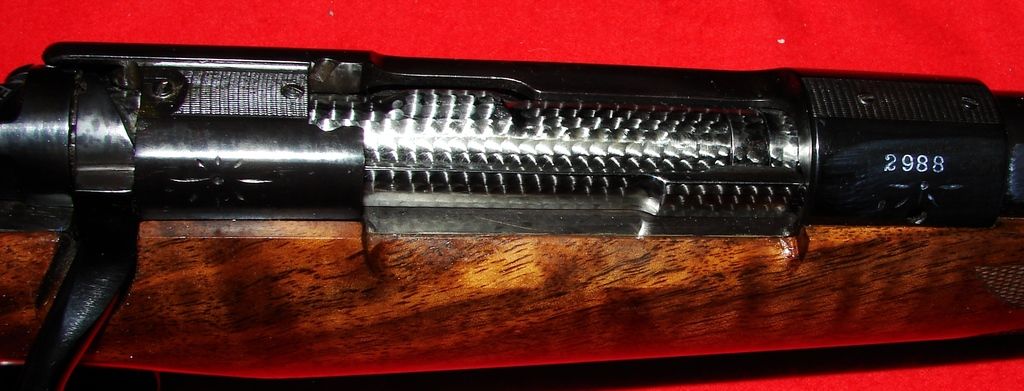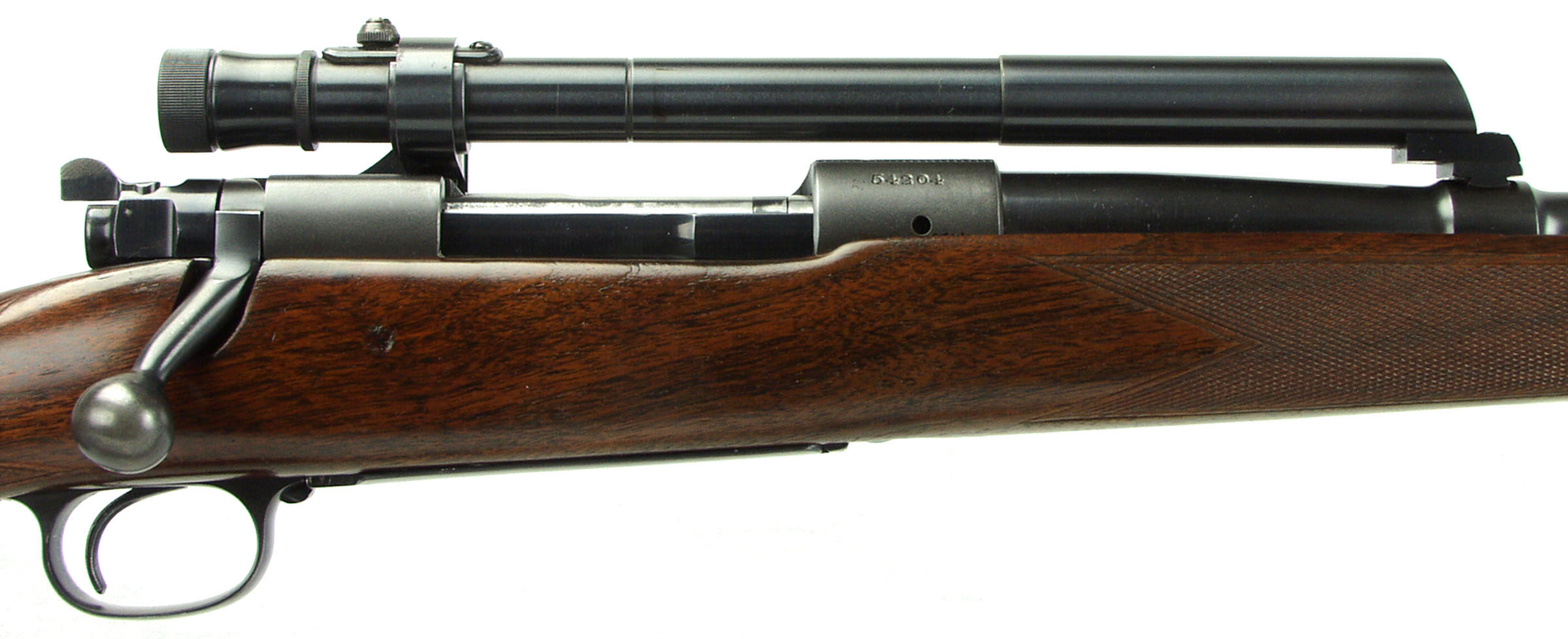April 10, 2015
 Offline
OfflineWhen looking at PreWar M70’s, what is the opinion on the rear portion of the receiver being factory drilled for a scope mount? My understanding is, to be safe, consider that none came from the factory that way. Yet some claim that they were drilled at the factory. Leupold and others offer scope mounts for PreWar guns that are somewhat universal. I think the cut off serial number is around 66,000. Basically, did rifles leave the factory prior to WWII drilled on the top of the rear portion of the receiver for a scope mount?
March 12, 2008
 Offline
OfflineI am quite certain Winchester did d/t some prewar model 70 receivers on a special order basis. However, without some type of proof, such as an original receipt stating such, I have always considered them aftermarket modifications. I think you will find most other model 70 collectors feel this way as well. This same concern come’s up constantly on model 52 sporter receivers made before the C model. It is always the seller stating he is certain they were special ordered and factory holes!
Steve
November 5, 2014
 Online
OnlineHi FLT-
I am assuming you are referring to D&T of the matted receiver bridge of a pre-war (type 1) Model 70 receiver (S/N <66,000 as you note) for the purpose of installing a top mount.
As Steve says, I am skeptical when it comes to a D&T receiver bridge on a pre-war gun (no matter what the seller claims). If you want to know why, just pick up a 1939 copy of the Stoeger Shooter’s Bible and look to see who was making top mounts for M70s at the time these pre-war rifles were being manufactured. Pretty much nobody. So if there was no product to mount, why order a gun with the bridge factory D&T?
The common top mounts for pre-war M70s, e.g. Redfield JR, Weaver, B&L and later others, didn’t come along until the post-war 40s, about the time that many shooters wanted to retrofit their pre-war rifles with ‘modern’ telescopic sights, and decent quality 7/8″, 1″ and 26 mm scopes were becoming affordable.
As far as commonly available scopes, the average pre-war customer was looking at something like a Weaver G330 (3/4″ tube) or early Lyman (pre-All Weather) Alaskan (7/8″ tube). (Just look at what the U.S. Military was putting on sniper rifles in WWII – those and the Unertl 8X target scope). After the war, good quality 26 mm tube scopes like the Stith/Kollmorgen/Redfield and 1″ tube scopes like the Weavers and Bausch & Lomb became available to the average sportsman, and lots of pre-war M70s were D&T to install them. In fact, I’d almost guarantee that any pre-war M70 with a single hole in the bridge that lines up with a Redfield JR one piece base is not factory D&T.
IMHO most authentic factory D&T pre-war guns would have been drilled for a side mount like the Griffin & Howe, since the popular thought in early days (when scopes were notoriously unreliable) was that back-up metallic sights were essential on any gun for field use. Even so, without some form of believable documentation I have to consider any M70 with a side mount to be non-original.
As a bit of an aside… While the smooth bridge of the Standard Length type 2 (transition) M70 receivers were factory D&T beginning somewhere around S/N 66,000, the H&H Magnum Length receivers were not routinely drilled until much later. So I am also skeptical of any H&H Magnum length receiver, type 2 (cloverleaf tang) or early type 3 (oval tang) below about 120,000 that has a drilled bridge.
Cheers,
Lou
WACA 9519; Studying Pre-64 Model 70 Winchesters
![]()
February 18, 2011
 Offline
OfflinePerhaps chiming in a bit late here, yet another point which needs to be addressed.
In a word… ‘Sthth”, the firm producing Model 70 mounts which were available prewar, were adapted to the Model 70 and were almost certainly the ‘convenient & cost efficient’ scope mount of choice. The Stith front mount was typically secured by utilizing the factory rear barrel sight dovetail. (Here a pix worth a thousand words.) Such replacing the rear barrel open sight; such by then made superfluous. The rear mount secured by using the existing left side bridge receiver sight mounting D&T fastening holes.
Indeed, I have a few ‘prewar’ Models 70 using Stith mounts. Those a bit clumsy compared to later svelte top mounts. Yet a contemporary scope solution at very modest costs. (Nowadays these very Stiths are pricey items.) A last factor to be appreciated is that Stith continued to offer these prewar 70 mounts into the postwar era. That as prewar 70 owners in a postwar world wanted the simplest solution to their scope mounting needs. Stith offered 3/4, 7/8 & 1″ scope tube size mounts.
I agree with the above statements that: 1. in the category of ‘never say never’, likely Winchester did some custom mount drilling on prewar 70 rifles. But the hangup as also noted, documentation, documentation and documentation… Here as in lack of! The odds horrendously small and the old adage never more true: Buy the gun, not the story! Otherwise we’d have thousands of duplicate ‘one of a kind’ articles kicking about for sale!
Just as a last aside. Stith also made the same engineered ‘no drill’ installations for such as Savage Model 99 guns. I have a nice little 99 Model “H” Carbine, c. 1938, in .250/3000 wearing an early period correct Lyman Alaskan scope and pointedly here, correct Stith mounts.
With all due respect, the ‘third hole’ syndrome in these prewar 70 rifles is a classic collector turnoff and will continue to be! (And yes I do have a few of them myself as classy old shooters.)
My take
October 10, 2014
 Offline
OfflineNRA, SAFARI CLUB INT'L SASS LIFE MEBER, POW MIA ACTIVE MEMEBER.
November 5, 2014
 Online
OnlineHere’s iskra’s pic, but I doubt it is worth a thousand of his words!
Rifle is a nothing special 30 GOV’T ’06 standard S/N 54204 that would have been assembled post war from pre-war parts. Bridge not drilled, mount (carrying a pre-war Weaver G330) attached to left side of the receiver via the the receiver sight mounting holes.
WACA 9519; Studying Pre-64 Model 70 Winchesters
![]()
October 27, 2012
 Offline
OfflineA couple of points that might clarify:
Factory D&T receiver holes were counter sunk (check looking straight into the holes with a magnifier). Most of the after market holes were not counter sunk. Some of them even have a “collar” of raised metal around the lip of the hole.
M70 action steel was very hard and tough on drill bits as small as those necessary to D&T the rear bridge. Plus, there was often heat buildup during the drilling. Check around the holes for discoloration.
Regarding Griffin&Howe sidemounts, by far, most were NOT put on at the factory. But it is well documented that some were. I’ve examined five that were on Dr. Russell C. Smith’s Ulrich engraved M70s (unquestionable documentation) plus a few others, and the bases were all above the wood. Most of the non-factory G&H sidemounts were a little below the stock line and required a notch in the wood. Plus none of the factory mounts had the three screw heads ground flush with the base. G&H sometimes did this when they installed the bases.
One additional point: Although Roger Rule claimed some post-war H&H Magnum receivers had a single hole in the rear bridge, I’ve not found proof. If it’s true, again..most were non-factory, I think.
All-in-all, my rule of thumb for rear bridge holes or G&H sidemounts is “guilty until proven innocent.”
1 Guest(s)


 Log In
Log In













